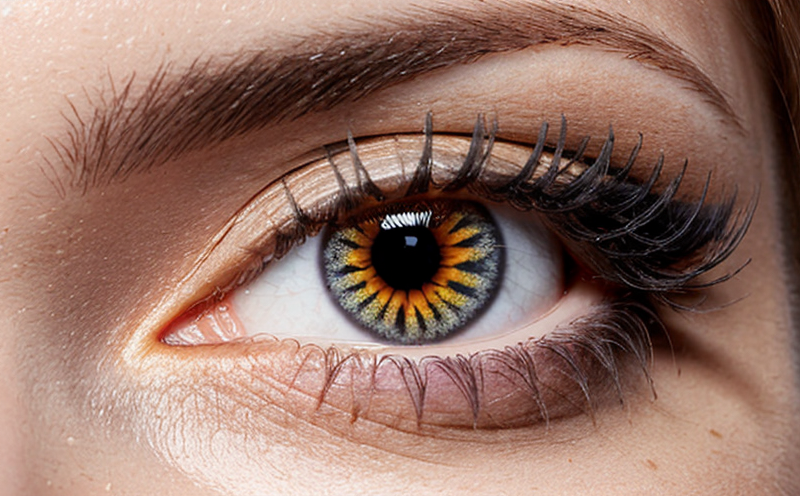Long-Term Ocular Safety Testing in Cosmetic Use
The long-term ocular safety testing of cosmetics is a critical component of ensuring product safety and compliance with international standards. This service is particularly important for products intended to come into direct contact with the eye, such as mascara, eyeliner, eyeshadow, and other ocular cosmetic items. The objective is to evaluate the potential adverse effects that prolonged use might have on the health of the eye and surrounding areas.
The testing methodology involves several phases, including initial irritancy assessment followed by long-term exposure studies. This process helps in identifying any adverse reactions that may occur over extended periods of usage. The test subjects are typically rabbits or other suitable animal models, which undergo controlled conditions to mimic real-life scenarios as closely as possible.
The primary focus is on assessing the effects of prolonged use on various parameters such as corneal opacity, conjunctival hyperemia, and eyelid inflammation. These observations are recorded over a specified period, usually ranging from 21 days up to several months, depending on the product type and intended use.
Specimen preparation involves selecting appropriate samples that represent the cosmetic formulations accurately. The samples are then tested under controlled conditions to simulate real-world application methods. This includes testing the products for both direct contact with the eye as well as potential indirect effects from prolonged usage.
The instrumentation used in these tests is advanced and precise, ensuring accurate measurements of any changes observed during the study period. Reporting is detailed and comprehensive, providing a thorough analysis of all findings, including images, videos, and quantitative data where applicable.
- Initial irritancy assessment
- Prolonged exposure studies over varying durations
- Observation of corneal opacity, conjunctival hyperemia, and eyelid inflammation
- Use of advanced instrumentation for accurate measurements
Compliance with international standards such as ISO 10993-10 and ASTM F825 ensures that the testing meets the highest safety and reliability benchmarks. This service is essential for quality managers, compliance officers, R&D engineers, and procurement teams to ensure that their products are safe for consumers.
Why It Matters
The importance of long-term ocular safety testing in cosmetic use cannot be overstated. Consumers expect high standards from the cosmetics they purchase, especially those designed to come into direct contact with their eyes. A single case of severe eye irritation or infection can have lasting consequences for both the consumer and the brand.
- Ensures compliance with international regulations
- Reduces the risk of product recalls due to safety issues
- Improves brand reputation by demonstrating a commitment to quality and safety
- Avoids legal challenges and potential financial losses from lawsuits
The testing process is not only about meeting regulatory requirements but also about protecting consumer health. By identifying any potential adverse effects early in the development phase, manufacturers can make necessary adjustments to their formulations before they reach the market.
Furthermore, long-term ocular safety testing provides valuable insights into the longevity and stability of cosmetic products under real-life conditions. This information is crucial for product developers who aim to create products that not only meet regulatory standards but also perform exceptionally well in practical applications.
Quality and Reliability Assurance
The quality and reliability of ocular safety testing services are paramount to ensuring the accuracy and consistency of results. At our laboratory, we employ a stringent quality management system that adheres to international standards such as ISO 17025 and ISO 9001.
- Stringent quality control measures
- Regular calibration of all testing equipment
- Trained and certified personnel performing the tests
- Comprehensive validation protocols for new test methods
The reliability of our services is further enhanced through rigorous validation processes. We ensure that all testing procedures are validated against known positive controls, negative controls, and reference materials to confirm their accuracy and precision.
We also maintain a robust data management system that ensures the integrity and traceability of all test results. This allows us to provide detailed reports that can be easily understood by regulatory bodies and internal stakeholders alike.
International Acceptance and Recognition
The recognition and acceptance of ocular safety testing results from reputable laboratories like ours are crucial for the global market. Our services comply with international standards such as ISO 10993-10, ASTM F825, and EN 1483.
- ISO 10993-10: Biological evaluation of medical devices
- ASTM F825: Standard specification for ocular cosmetic products
- EN 1483: Cosmetics - Ocular safety testing
The international acceptance of our services is further bolstered by our affiliation with global regulatory bodies and industry associations. This ensures that the results we provide are widely recognized and accepted in markets around the world.
We understand the importance of consistency across borders, which is why we maintain the highest standards regardless of where the product will be sold. Our commitment to excellence in ocular safety testing services has earned us a reputation for reliability and accuracy.





